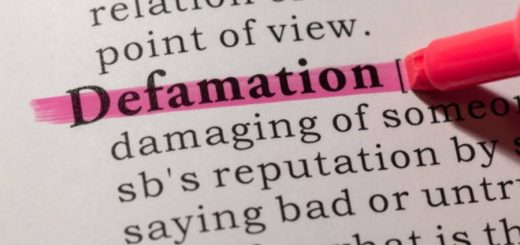Snoop Dogg Clickbait and Free Speech: How the Challenges of Canadian Political Campaigns Will Test Ontario’s New Anti-SLAPP Legislation
In the past few months, Canadians have focused, often in disbelief, on the spectacle that is the 2016 United States Presidential Election. The latest controversy revolves around a New York Times article entitled “Two Women Say Donald Trump Touched Them Inappropriately.” Regardless of its contents, the article’s title alone is enough to send any political campaign into a frenzy. Mr. Trump was quick to issue a letter via his lawyer to the New York Times. The letter called the article slanderous and asked for an apology. The response from the New York Times’ Assistant General Counsel was swift in its refusal to comply. The response pointed out that the article had done what the law allows, publishing “newsworthy information about a subject of deep public concern”(see full letter here). Of course, The New York Times has ample resources to deal with an eventual libel claim, which seems unlikely in this particular case. But what about the Canadian context?
What Does This Have To Do With Canada?
I provide the above example to begin a topical conversation on Strategic Law Suits Against Public Participation or “SLAPP” suits. SLAPP suits often arise in the context of defamation suits, to which Canadians are no strangers. The 2014 Municipal Election in Toronto and the 2015 Canadian Federal Election have produced two such cases. The novelty and interest in these two cases is not the nature of the claims themselves, but the fact that they will be the first to test Ontario’s Bill-52, Protection of Public Participation Act, SO 2015, c 23 [Bill-52], which became law in October 2015. Bill-52 is Ontario’s attempt at curbing the harm done by SLAPP suits.
SLAPP suits aim at penalizing and deterring citizens from participating in public affairs. These suits often involve a power imbalance. They may pit a large corporation or politician against individual citizens who advocate their positions publicly through meetings, picketing, protests, or published material. The goal of SLAPP suits is not necessarily the amount of money recovered in damages. The real goal is intimidation into silence. The favoured cause of action for these suits is often defamation.
Protection of Public Participation in Ontario
Bill-52, among other legislation, amended the Courts of Justice Act, RSO 1990, c C 43 [CJA] by creating sections 137.1 through 137.5, which fall under the heading of “Dismissal of proceeding that limits debate.”
Section 137.1(1) outlines the purposes of the section as:
(a) to encourage individuals to express themselves on matters of public interest;
(b) to promote broad participation in debates on matters of public interest;
(c) to discourage the use of litigation as a means of unduly limiting expression on matters of public interest; and
(d) to reduce the risk that participation by the public in debates on matters of public interest will be hampered by fear of legal action. [emphasis added]
Procedurally, section 137.1(3) outlines that “on motion by a person against whom a proceeding is brought, a judge shall, subject to subsection (4), dismiss the proceeding against the person if the person satisfies the judge that the proceeding arises from an expression made by the person that relates to a matter of public interest.”
In contrast, section 137.1(4) states that a motion to dismiss proceedings shall not be issued if:
(a) there are grounds to believe that,
(i) the proceeding has substantial merit, and
(ii) the moving party has no valid defence in the proceeding; and
(b) the harm likely to be or have been suffered by the responding party as a result of the moving party’s expression is sufficiently serious that the public interest in permitting the proceeding to continue outweighs the public interest in protecting that expression. [emphasis added]
Another important section is 137.1(5), which states that once a motion has been filed under section 137.1, there will be no further action in the original proceeding until the motion has been heard. Since the original action is paused, section 137.2(2) then requires the courts to hear the motion to dismiss within 60 days. These two sections combined are quite innovative and an important tool in expediting a highly stressful process. However, we are yet to see how the 60 day hearing deadline will be applied by an overburdened court system.
The Cases
The two aforementioned cases, which are likely to set a starting standard and clarify some of the ambiguities in section 137.1 of the CJA, will likely be heard this year in Toronto courts. The first one involves former Richmond Hill City Councillor Nick Papa who, after 18 years on the job, lost his seat in the 2014 Municipal Election. Mr. Papa is suing local resident Frank Zeppieri. Mr. Zeppieri is accused of creating an election ad in a local newspaper with Mr.Papa’s picture and the word “UNWANTED” plastered over his face. Other claims against Mr. Zeppieri involve a Facebook page devoted to Mr.Papa that displayed an image of rapper Snoop Dogg. For a detailed media synopsis of the case see here.
The second case involves Tracey Newman, a freelance journalist from Milton, Ontario. She is being sued for $17.5 million by former federal Liberal candidate and business person Azim Rizvee and wife Rabiya Azim. In Facebook and rabble.ca posts, Ms. Newman alleged that she was intimidated by Mr. Rizvee’s supporters during the election. Their dispute stems from Ms.Newman’s support of a different candidate who lost the Liberal nomination to Mr. Rizvee. For a copy of Ms. Newman’s motion under section 137.1 of the CJA see here.
What Next?
Hearings for both motions have been postponed several times. Most recently, the presiding Judge over Mr. Zeppieri’s motion stated that the hearing would require two full days and the next available time at the Newmarket Court was in June of 2017. So much for the 60 day guarantee! In the meantime, parties have agreed to move proceedings to Toronto, in the hope that they would be heard sooner. However, much of the harm from SLAPP suits comes from the uncertainty that defendants face while a lawsuit is pending. Mr. Zeppier has had that uncertainty hanging over his head for over a year now, in addition to what must be mounting legal costs. Worse still, Ms. Newman faces the exorbitantly high claim of $17.5 million in damages against her.
Leaving the timing aside, when the courts deal with these motions, the first hurdle will be to determine whether the actions targeted by the original lawsuit involve a matter of public interest. In Grant v Torstar Corp, 2009 SCC 61 [Grant], a defamation case, the Supreme Court of Canada (“SCC”) did not devise a specific test for “public interest” when outlining the defence of “responsible communication on matters of public interest.” Justice McLachlin stated that “public interest may be a function of the prominence of the person referred to in the communication, but mere curiosity interest is not enough. Some segment of the public must have a genuine stake in knowing about the matter published” (Grant, para 105). For more on Grant, see Ahsan Mirza’s analysis for TheCourt.ca here. The courts will likely have to look elsewhere for guidance on how to determine “public interest” and thus this will likely be an evolving concept.
Once the defendant in the original lawsuit establishes that a “public interest” is engaged, the burden shifts to the plaintiff to show that there are “grounds to believe” that the action has “substantial merit.” I could not find any case law that outlined a standard for “grounds to believe.” Such a standard could be something less than a balance of probabilities. Needless to say, this is also an area where courts will be asked to outline something from scratch.
Ultimately, the question rests on whether the public interest in the harm suffered, or likely to be suffered, by the plaintiff is sufficiently serious that it outweighs the public interest in protecting expression. How courts will balance these two competing interests is still to be determined. In the meantime, an interesting question is whether the amount of damages being asked for will play a role in any of these balancing inquiries?
Courts are rightfully cautious in approaching these motions. An inquiry will have to look at defining a matter of “public interest,” determining what “grounds to believe” and “substantial merit” mean and devising a test to balance off competing interests. With so much uncertainty, it is no wonder that judges seem to be dragging their feet. A prediction on any of these motions seems futile at this point, but these cases are definitely two to watch.







Join the conversation